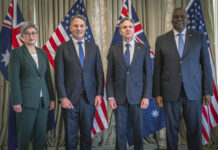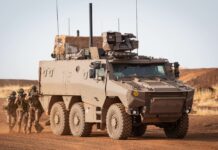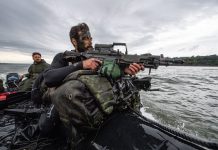Singapore’s commitment to strong national defence and ability to equip its forces with
state-of-the-art equipment, provides a powerful deterrent capability.
Singapore is a small island nation, with a land area amounting to just 719 sq. km and a population of 5.866M, the vast majority of whom live in urban areas. As such, it would be correct to define Singapore as a city-state. However, it is a city-state with virtually no natural resources, though it is an economic success story with a Gross Domestic Product (GDP) per capita equivalent to the major economic powers of Western Europe. Furthermore, this economic success story has been achieved in a relatively short period, as Singapore only became an independent nation on 9 August 1965.
On independence, Singapore’s primary asset was its deep-water ports and its status as a regional trading centre, an entrepôt where goods were imported, stored and exported across Southeast Asia and beyond. Singapore also had a strategic location at the base of the Malacca Strait and on the Singapore Strait, recognised as one of the most important global shipping channels. More recently, its importance has grown even further, as the Malacca Strait was classified as the second most important oil choke point globally, surpassed in importance only by the Straits of Hormuz between the Persian Gulf and the Gulf of Oman. According to the Singapore Ministry of Defence (MINDEF): ”Singapore sits at the convergence of key global shipping routes and seaborne trade is the lifeblood of our economy. Today, about 70 per cent of the world’s maritime trade transits through the Singapore Strait and carries about 80 per cent of our food supplies.”
Singapore could also point to another advantage on independence, the fact that the new nation was the site for numerous of British air and naval bases, plus garrisons. The presence of the British, along with Commonwealth forces from Australia and New Zealand, provided a defensive shield for Singapore while it developed its own national defence structure. Perhaps more importantly though, these bases were a major source of employment for the Singaporean population and the goods and services purchased by foreign military personnel and their dependents were a positive factor for the local economy.
A Defining Moment
In July 1967, as a part of its plan to end its defence commitments ‘East of Suez,’ the British Government announced that it would withdraw its forces from Singapore by the mid-1970s. In January 1968, the British Government stated that the withdrawal would be sped up and that the British military presence in Singapore would be ended by 1971.
For Singapore, this British decision came as a massive blow. Singapore was in the process of developing its own national defence structure, its first 900 conscripts for the Singapore military had only started training in August 1967, and therefore being able to train and equip national armed forces by 1971 was going to be a massive challenge for Singapore. Then there was the economic damage that would come from the British/Commonwealth military withdrawal, as the bases provided over 20 per cent of Singapore’s Gross National Product (GNP) and employed about 25,000 people.
In the end, the majority of British troops left by October 1971, with the remainder departing in March 1976. The Australian ground forces had departed by December 1975, although the New Zealand military presence in Singapore continued on a small scale until 1989. The way that the British military withdrawal was handled created a degree of bad feeling and it could be argued that this has been a significant factor in the lack of success enjoyed by British defence companies in winning programmes in Singapore compared to their European competitors.
The British/Commonwealth withdrawal could have been a catastrophe for Singapore, however, the fact that it was not speaks volumes for the capabilities of the People’s Action Party (PAP) government of the time. It was also a contributory factor to the fact that the PAP have been the party of government in Singapore ever since independence.
The Singapore Government, once it realised that they could not persuade the British to change their mind, looked to make the best of the situation. They were able to extract a soft loan of £50M from the British Government (in current value terms, accounting for inflation, this equates to £752.4M or €902.9M today). The deal also involved the transfer of the integrated air defence system in Singapore to Singaporean control and the British would provide operational and training assistance. At the end of the 1960s, Singapore also received Hawker HUNTER aircraft from Britain, along with training for aircrew and maintenance personnel. At the same time, Singapore purchased its first helicopters in the shape of the Aerospatiale ALOUETTE III. Aerospatiale is a legacy company of Airbus Helicopters and today, some 50 years on, the Republic of Singapore Air Force (RSAF) is still flying and buying Airbus Helicopters.
The big prize, however, was that Singapore received all of the land that had been occupied by the British military, including airfields, dockyards and garrisons. This provided all of the facilities necessary for the newly emerging Singapore Armed Forces (SAF) and included four airbases at Changi, Seletar, Sembawang and Tengah. Commercially, the Royal Navy dockyard and related facilities, plus their associated workforce, allowed Singapore to enter the ship repair and shipbuilding business. Elsewhere, the availability of a large ex-military land area, along with the government providing incentives for foreign direct investment and the availability of a skilled workforce hailed a new economic era in Singapore. In many respects, the British withdrawal turned out to be a blessing in disguise, as it forced Singapore to take charge of its economic and political destiny.
Towards the Present
Since the 1970s, Singapore’s economy has developed from a base of low cost manufacture and developed up the value chain to reach high levels of sophistication. This was achieved thanks to good governance, freedom from corruption, the rule of law and sound economic development policy. These days, Singapore’s economic picture has expanded from a reliance on the industrial sector, into a mixed economic structure with a very strong services sector. It is a diverse economy spanning from financial services, to oil refining, to biotechnology, to electronics and beyond. The country also has a world class educational and medical system.
Like everywhere else in the world, Singapore was hit hard by COVID; according to the World Bank, Singapore’s GDP growth was unprecedented at minus 5.4 per cent in 2020. In 2021, there was a rebound, and according to the Singapore Government in November 2021: “The Ministry of Trade and Industry (MTI) announced today that Singapore’s GDP growth is expected to come in at “around 7.0 per cent” in 2021 and “3.0 to 5.0 per cent” in 2022.” These figures for 2022 match the IMF’s projections. Even in the midst of the COVID crisis, Singapore’s economy proved how robust it was and illustrated sound economic management by the Singapore Government.
This sound economic management has also had a significant impact on defence spending in Singapore; put simply, consistently good economic performance translates into consistent levels of defence expenditure. This is confirmed by data sets from the Stockholm International Peace Research Institute (SIPRI) Military Expenditure Database. In terms of military expenditure as a percentage of GDP, in the ten years between 2011 and 2020, the lowest figure was 2.8 per cent, while the highest was 3.2 per cent. The average for military expenditure as a percentage of GDP was 3 per cent.
Another measure of defence expenditure used by SIPRI is military expenditure in a constant value of 2019 million US Dollars. In 2011, it was $8,735M, $8,706 in 2012, $8,961 in 2013, $9,557 in 2014, $10,162 in 2015, $10,432 in 2016, $10,524 in 2017, $10,682 in 2018, $11,020 in 2019 and $10,856 in 2020. The point to remember is the conversion to US Dollars from Singapore Dollars, as one has to take into account exchange rate fluctuations. However, the vast majority of fixed costs that the Singapore MINDEF has to deal with, such as personnel, pensions, medical, facilities and so on are all denominated in local currency, therefore the MINDEF/SAF financial picture is generally better than these US dollar denominated figures might imply.
The reason for this strong level of commitment to defence spending goes back to the first generation of political leaders on independence in 1965, as they remembered the fall of Singapore in 1942 to the Imperial Japanese Army and the horrors of occupation, and as such, were determined that would never be repeated. Equally important was the fact that on independence, Singapore was a small island nation surrounded by generally hostile neighbours, added to which at that time, Southeast Asia was an area of superpower conflict by proxy.
Singapore’s commitment to a strong national defence and ability to equip its forces with state-of-the-art equipment provides a powerful deterrent capability. This is further strengthened by astute diplomacy, as Singapore is one of the few countries in Asia to have positive diplomatic relations with both China and the US. Furthermore, relations with neighbouring states that were once difficult are now cordial. The problem is that the Asia-Pacific region as a whole is becoming the venue for strategic rivalry between China and the US, a rivalry that is drawing in both regional states and external actors. As a result, new security threats are emerging, meaning that Singapore will have to continue to enhance both its defences and its diplomacy.
Money and Procurement Matters
In FY2020, the Singapore defence budget was SGD 13.63Bn (US$ 10.126Bn), with the budget 3.7 per cent down on the 2019 figure. Things changed dramatically when the FY2021 budget was announced on 1 March 2021, as the budget had increased to SGD 15.36Bn (US$ 11.412Bn), an increase of 12.7 per cent. Minister for Defence, Dr. Ng Eng Hen, noted that this was the first double-digit growth year-on-year in the defence budget since 1998, with only the Ministry of Health allocated a larger budget by the Singapore Government. The main contributing factor for the budget increase in 2021 was the fact that the FY 2020 budget was underspent by SGD 1.73Bn (US$ 1.284Bn); the cause of this was COVID, in that equipment deliveries were delayed due to the pandemic and this meant that payments did not have to be made to suppliers. Post-COVID, Dr. Ng noted that ”MINDEF expects its budget to stabilise and return to a growth trajectory targeted and announced in previous years – about three to four per cent nominal growth each year, to keep pace with inflation over a period.”
Key Programmes
One of the key programmes impacted by COVID was the INVINCIBLE class (Type 218SG) submarine programme for the Republic of Singapore Navy (RSN). In December 2013, Singapore placed an order with thyssenkrupp Marine Systems for two Type 218SG submarines for delivery to Singapore in 2021 and 2022. Then in May 2017, a second order for two more Type 218SG submarines was placed, with deliveries expected from 2024 onwards. In December 2021, German media reports revealed that the outgoing Merkel government had given approval for a fifth Type 218SG submarine to be sold to Singapore, although there was no confirmation from Singapore that this acquisition would proceed. Due to COVID, RSS INVINCIBLE, the lead ship of the submarine class, will only be arriving in Singapore this year.
The other important future RSN programme is the Multi-Role Combat Vessel (MRCV), which will replace the current Lürssen designed VICTORY class corvettes, six of which were commissioned between 1990 and 1991. Prior to the VICTORY class, Lürssen had provided six SEA WOLF (TNC-45) missile gunboats to the RSN. The MRCV is due to replace the VICTORY class from 2030 onwards, with the first MRCV on course to be delivered in 2025.
The Republic of Singapore Air Force (RSAF) is building up to selecting a replacement for its F-16C/D Block 52 fleet numbering 20 F-16C and 40 F-16D aircraft. In March 2020, Singapore signed up for four Lockheed Martin F-35B JSF and these will be delivered in 2026. The aircraft will be based in the US and used for in-depth evaluation and training, and assuming all goes well, a second order for eight F-35B will be placed. The F-16C/D will “will be progressively retired post-2030,” according to MINDEF, indicating further orders for batches of JSF as per Singaporean practice, although the total number of aircraft to be acquired is unclear at this point.
Defence planners in Singapore are in the fortunate position of being able to plan for the long term, secure in the fact that there are no ‘boom or bust cycles’ in defence budgeting and that defence funding will keep pace with inflation. The commitment of the Singapore Government to national defence, allied to a strong national economic picture, also means that should threat conditions evolve negatively, there would be extra funding available to respond if necessary.












